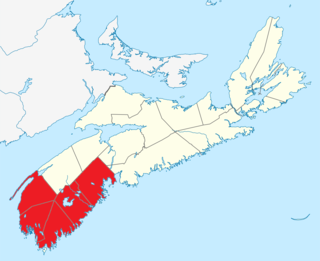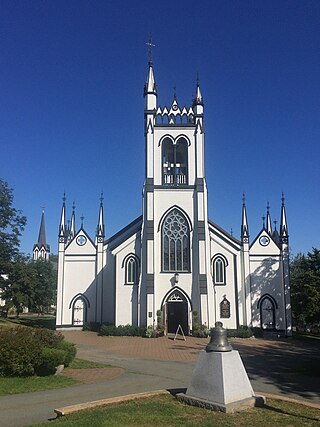Upper New Cornwall is a community in the Canadian province of Nova Scotia, located in the Lunenburg Municipal District in Lunenburg County.
Coordinates: 44°31′19.09″N64°34′12.3″W / 44.5219694°N 64.570083°W
Upper New Cornwall is a community in the Canadian province of Nova Scotia, located in the Lunenburg Municipal District in Lunenburg County.
Coordinates: 44°31′19.09″N64°34′12.3″W / 44.5219694°N 64.570083°W
The Lighthouse Route is a scenic roadway in the Canadian province of Nova Scotia. It follows the province's South Shore for 585 km (364 mi) from Halifax to Yarmouth.
Mill Cove is a community in the Canadian province of Nova Scotia, located in the Chester Municipal District on the Aspotogan Peninsula on the Lighthouse Route. The community was home to CFS Mill Cove from 1967 til the 1990s.
Upper LaHave is a community in the Canadian province of Nova Scotia, located in the Lunenburg Municipal District in Lunenburg County on the shore of the LaHave River.
Chelsea is a community in the Canadian province of Nova Scotia, located in the Lunenburg Municipal District in Lunenburg County, Nova Scotia. It was probably named for Chelsea, London.
Nineveh is a community in the Canadian province of Nova Scotia, located in the Lunenburg Municipal District in Lunenburg County. It was named for the ancient city of Nineveh.
New Cumberland is a community in the Canadian province of Nova Scotia, located in the Lunenburg Municipal District in Lunenburg County.
New Canada is a community in the Canadian province of Nova Scotia, located in the Lunenburg Municipal District in Lunenburg County.
Upper Chelsea is a community in the Canadian province of Nova Scotia, located in the Lunenburg Municipal District in Lunenburg County.
Middle New Cornwall is a community in the Canadian province of Nova Scotia, located in the Lunenburg Municipal District in Lunenburg County.
Pentz is a rural community in the Canadian province of Nova Scotia, located in the Lunenburg Municipal District in Lunenburg County.
New Elm is a community in the Canadian province of Nova Scotia, located in the Lunenburg Municipal District in Lunenburg County.
Blue Rocks is a community in the Canadian province of Nova Scotia, located in the Lunenburg Municipal District in Lunenburg County. It stands to seaward of Lunenburg, Nova Scotia, somewhat to the east. For many years a fishing village, it was discovered by many artists and photographers beginning in the 1940s. Today the village boasts many artists, and there are also numerous guest houses to be found among the fishermen's dwellings.
Upper Branch is a community in the Canadian province of Nova Scotia, located in the Lunenburg Municipal District in Lunenburg County.
Upper Northfield is a community in the Canadian province of Nova Scotia, located in the Lunenburg Municipal District in Lunenburg County.
Lake William is a community in the Canadian province of Nova Scotia, located in the Lunenburg Municipal District in Lunenburg County.
Stonehurst is a community in the Canadian province of Nova Scotia, located in the Lunenburg Municipal District in Lunenburg County.

Southern Nova Scotia or the South Shore is a region of Nova Scotia, Canada. The area has no formal identity and is variously defined by geographic, county and other political boundaries. Statistics Canada, defines Southern Nova Scotia as an economic region, composed of Lunenburg County, Queens County, Shelburne County, Yarmouth County, and Digby County. According to Statistics Canada, the region had the highest decrease of population in Canada from 2009 to 2010, with a population decrease of 10.2 residents per thousand. The region also has the second-highest median age in Canada at 47.1 years old.

St. John's Anglican Church was the first church established in Lunenburg, Nova Scotia, Canada (1753). It is the second Church of England built in Nova Scotia, and is the second oldest continuous Protestant church in present-day Canada. Early on 1 November 2001, St. John's church suffered significant damage by fire. It was restored and re-dedicated June 12, 2005.
The Hillcrest Cemetery is the oldest protestant cemetery in Lunenburg, Nova Scotia and one of the oldest in Canada. The cemetery is adjacent to the Lunenburg Academy. The oldest marker is dated 1761, eight years after Lunenburg was established. Hillcrest Cemetery contains 5 Commonwealth war graves from World War I and one from World War II.

A township in Nova Scotia, Canada, was an early form of land division and local administration during British colonial settlement in the 18th century. They were created as a means of populating the colony with people loyal to British rule. They were typically rural or wilderness areas of around 100,000 acres (400 km2) that would eventually include several villages or towns. Some townships, but not all, returned a member to the General Assembly of Nova Scotia; others were represented by the members from the county. Townships became obsolete by 1879 by which time towns and counties had become incorporated.